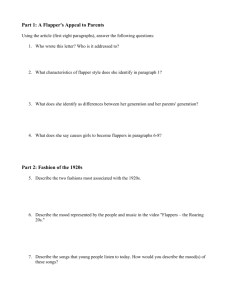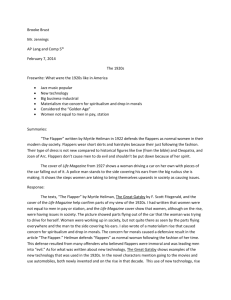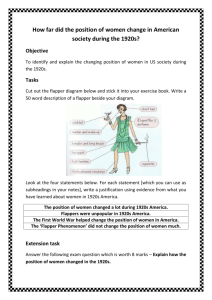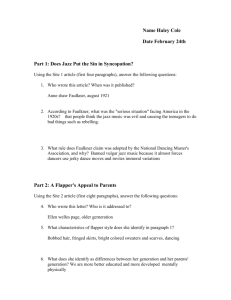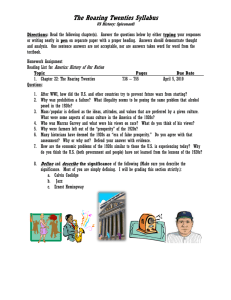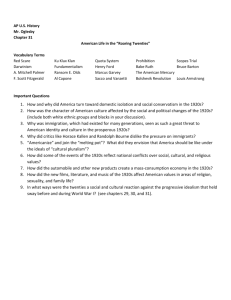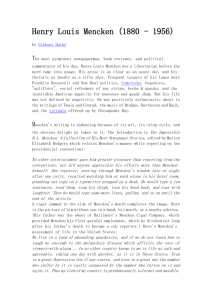Alcohol, Sex, and Jazz
advertisement
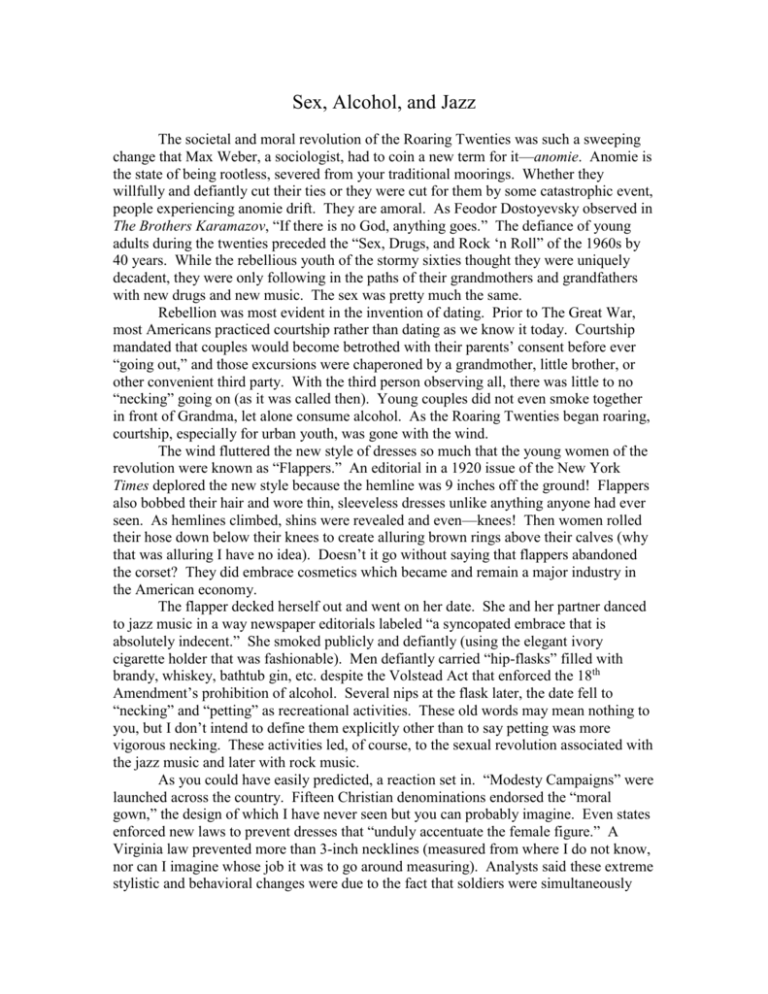
Sex, Alcohol, and Jazz The societal and moral revolution of the Roaring Twenties was such a sweeping change that Max Weber, a sociologist, had to coin a new term for it—anomie. Anomie is the state of being rootless, severed from your traditional moorings. Whether they willfully and defiantly cut their ties or they were cut for them by some catastrophic event, people experiencing anomie drift. They are amoral. As Feodor Dostoyevsky observed in The Brothers Karamazov, “If there is no God, anything goes.” The defiance of young adults during the twenties preceded the “Sex, Drugs, and Rock ‘n Roll” of the 1960s by 40 years. While the rebellious youth of the stormy sixties thought they were uniquely decadent, they were only following in the paths of their grandmothers and grandfathers with new drugs and new music. The sex was pretty much the same. Rebellion was most evident in the invention of dating. Prior to The Great War, most Americans practiced courtship rather than dating as we know it today. Courtship mandated that couples would become betrothed with their parents’ consent before ever “going out,” and those excursions were chaperoned by a grandmother, little brother, or other convenient third party. With the third person observing all, there was little to no “necking” going on (as it was called then). Young couples did not even smoke together in front of Grandma, let alone consume alcohol. As the Roaring Twenties began roaring, courtship, especially for urban youth, was gone with the wind. The wind fluttered the new style of dresses so much that the young women of the revolution were known as “Flappers.” An editorial in a 1920 issue of the New York Times deplored the new style because the hemline was 9 inches off the ground! Flappers also bobbed their hair and wore thin, sleeveless dresses unlike anything anyone had ever seen. As hemlines climbed, shins were revealed and even—knees! Then women rolled their hose down below their knees to create alluring brown rings above their calves (why that was alluring I have no idea). Doesn’t it go without saying that flappers abandoned the corset? They did embrace cosmetics which became and remain a major industry in the American economy. The flapper decked herself out and went on her date. She and her partner danced to jazz music in a way newspaper editorials labeled “a syncopated embrace that is absolutely indecent.” She smoked publicly and defiantly (using the elegant ivory cigarette holder that was fashionable). Men defiantly carried “hip-flasks” filled with brandy, whiskey, bathtub gin, etc. despite the Volstead Act that enforced the 18th Amendment’s prohibition of alcohol. Several nips at the flask later, the date fell to “necking” and “petting” as recreational activities. These old words may mean nothing to you, but I don’t intend to define them explicitly other than to say petting was more vigorous necking. These activities led, of course, to the sexual revolution associated with the jazz music and later with rock music. As you could have easily predicted, a reaction set in. “Modesty Campaigns” were launched across the country. Fifteen Christian denominations endorsed the “moral gown,” the design of which I have never seen but you can probably imagine. Even states enforced new laws to prevent dresses that “unduly accentuate the female figure.” A Virginia law prevented more than 3-inch necklines (measured from where I do not know, nor can I imagine whose job it was to go around measuring). Analysts said these extreme stylistic and behavioral changes were due to the fact that soldiers were simultaneously close to violent death and French prostitutes during the war. They said the men returned to challenge the entire system of American beliefs. To that I say it takes two to “flap,” and young women joined the men in a quest for sensation 40 years before “flappers” became “hippies.” Six societal influences contributed to the enormity of the societal and sexual revolution. First, women had been given the right to vote at last. They reasoned that if they could vote like men, they should be able to drink and smoke like men. Being the political equals of men made some women assert their sexual equality as well. Next, new convenience items like canned foods, store-bought clothes, washing machines, and vacuum cleaners gave women something else they had never had—free time. The most ardent flappers viewed their city homes as sort of a dormitory, a place one went only to wash and to sleep. Urbanization decentralized the American family and created “the street” and “night life.” Thirdly, the anti-Victorian ideas of Sigmund Freud made their way across the Atlantic. While even psychologists and psychiatrists have largely discredited Freudianism today, in the 1920s is was in vogue to talk about him. On “the street,” his ideas were interpreted to mean self-control was dangerous and sex was necessary for health. Those ideas sure livened up the “night-life.” Prohibition itself contributed to societal revolution by inspiring a spirit of deliberate revolt. While the consumption of alcohol went down during the 1920s, drinking was a large part of the youth revolt. “Speakeasies,” secret night clubs that required passwords, offered “bootleg” gin to those with connections. Telling flappers and soldiers not to drink was like putting a bucket of stones outside a window bearing a sign, “Don’t throw rocks through this window.” Right along with alcohol, the automobile helped the revolt by providing the means to escape supervision. Interestingly, in 1919 only 10% of cars had enclosed tops. By 1927 83% of cars were enclosed to produce what one analyst called, “. . . houses of prostitution on wheels.” A judge who tried 30 girls in cases of sexual misconduct in his courtroom in one day reported that 19 of the 30 had “misconducted” themselves in a car. Note that neither grandmothers nor little brothers can outrun automobiles. Movies and magazines enflamed audiences. Bernarr McFadden, the publisher of True Story magazine said his “Confessions of Youth” genre was intended to “arouse the audience without arousing the censor.” Girls and women were supposed to have written stories about their evening escapades and mailed them in to be published. His magazine, started in 1919, still holds an unparalleled growth record in publishing history. By 1923, True Story had attained a circulation of 300,000 copies. By 1924 it sold 848,000 copies. By 1925 that rose to 1.5 million. In 1925 it peaked at 2 million copies. For the purposes of your education only, your teacher has researched the situation and determined that True Story is still published today. I haven’t researched the movies of the 1920s which were not rated and therefore titillating to say the least. Even the advertisements for these films were suggestive. One movie poster said that the movie it advertised contained, “Brilliant men, beautiful jazz babies, champagne baths, midnight revels, petting parties in the purple dawn—neckers, petters, white kisses, red kisses. The truth—bold, naked, sensational—all ending in one terrific smashing climax that makes you gasp!” Is it any wonder that the parents of American youth were aghast, shocked that such things were openly discussed at all? Keep in mind they were never openly discussed before. The youth revolting in the 1920s became so dissipated they eventually revolted even themselves with their obsessions. One wife, convinced that the new morality said sharing her husband with his mistress was good, found herself vomiting whenever the other woman was around. Amorality did not sit well with her stomach, apparently. Social commentator Joseph Wood Krutch said, “If sex has come to be less often a sin, it has also come to be less often a supreme privilege.” Prior to the 1920s the Pulitzer Prize for the Novel standards said the novel selected had to “. . . present the wholesome atmosphere of American life.” In the 1920s the standards were changed to read, “. . . whole atmosphere of American life.” The twenties produced winners like Theodore Dreiser’s American Tragedy in 1927. Dreiser had already produced Sister Carrie, a novel about a young woman in a city who eventually “slept her way” to becoming a famous stage actress. American Tragedy conveys the story of a flapper who became pregnant. Her beau invites her away from the city in order to marry her and enjoy a honeymoon at a resort. As he rows her out on the lake at the resort, she wonders why he brought along a tennis racquet and his suitcase. In the middle of the lake, the man pushed his “beloved” out into the water. Heavily pregnant and wearing a matronly dress rather than a flapper dress, she sinks, splutters back to the surface where the man strikes her on the head with the racquet. When she came back up again, he whacked her with a camera, and she went down for good. He rowed backed to shore and took his suitcase with him back to the train back to the city. What was needed, perhaps, was strong, moral leadership. Did Warren G. Harding provide it? No, Harding loved to play poker with his buddies at the White House while serving liquor during prohibition. He also sired an illegitimate daughter in the Senate Office Building. He wasn’t too keen on the issues, either. He was famous for desiring a move after World War I “back to normalcy.” The President misread his notes and coined a whole new word for “normality.” He took a firm stand on the tariff—he said, “We should adopt a protective tariff of such a character as will help the struggling industries of Europe to get on their feet.” Reporters left, speechless to think that such a person could become President of the United States. Surely my students know why this was an odd comment? Harding did not quite succeed in restoring a positive image for himself before he died trying. That left Calvin Coolidge, the man who said, “The business of America is business.” Yet he refused to work more than four hours a day as President. He slept eight hours a night and took a nap every afternoon. His favorite thing to do as President was to push the alert button and watch the Secret Service agents run about looking for the danger. He was notoriously taciturn. When sitting between two ladies at a state dinner, one leaned toward the President and said she had a bet on with the other that she could get Coolidge to say at least three words together in a row. Coolidge turned to her and said, “You lose.” Coolidge was a Jeffersonian, limited-government man of principle, the last such to be our president. He was not a reform crusader. He thought Theodore Roosevelt’s approach to leadership rather vulgar. Speaking of Progressives, what were they able to accomplish? They passed laws that closed barbershops on Sundays. In California, they outlawed wood shingle roofs. Meanwhile, 1/3 of the families in America lived below the $2,000/year poverty level and farmers’ prices dropped out of the bottom after the war. The great genius Henry Ford was even a presidential candidate, but he had some rather strange ideas. He advocated eradicating crime by changing American diets. He wanted to get rid of cows in order to remove their example of laziness from the sight of American workers. Ford used a portion of his personal fortune to fund assaults on a supposed Jewish plot to rule the world. He went on to help Adolph Hitler create a simple, affordable automobile for the German people, the Volkswagen. Writers continued to offer criticism. H. L. Mencken was America’s king of acerbic wit. He published the American Mercury magazine in which he called American democracy, “. . . the worship of jackals by jackasses,” which, for me, ranks right up there with Shakespeare’s barbed, “You, sir, are an idol of idiot-worshipers.” Mencken said Americans were “. . . the most timorous, sniveling, poltroonish, ignominious mob of serfs and goose-steppers ever gathered under one flag in Christendom.” He covered the Scopes Trial and surmised that Dayton, Tennessee, was ruled “. . . by gaping primates.” When a woman asked him why he stayed in the US if he despised it so, Mencken replied, “Why do men go to zoos?” Sinclair Lewis wrote the novel Babbitt that so powerfully captured the pathetic conformity of an insecure America that the word “babbittry” has entered our language like the word “quixotic.” The character Babbitt was a businessman obsessed with having all the “right” material possessions including his house, car, suit, pocket watch, cigars, breakfast cereal, children, and wife. Lewis said he had no answers; he only knew that answers could come only from free men. A new wave of immigration from war-ravaged Europe hit our shores at the rate of 5,000 a day entering at Ellis Island. An average of one million immigrants per year arrived throughout the 1920s. Nativism flared up in a 75,000-man KKK march in Washington, D. C. They held open meetings around the city and branded a black bellboy with “KKK” across his forehead. They called Jews “Christ-killers,” shot a Catholic priest, and burned Catholic churches. The Klan took over the entire state of Indiana during the 1920s from the Governor on down. Racist hate groups were not the only nativists. US Steel’s official position was to stir up as much bad feeling as possible between Serb and Italian immigrants in their steel mills in order to prevent unionization by perpetuating racial hatred among former European enemies. A Kansas City School teacher told Armenian immigrant Badasar K. Baghdigian when he enrolled in school, “Oh, give that [name] up and change it to Smith or Jones and become Americanized. Give up everything you brought with you from the Old Country. You did not bring anything worthwhile, anyway.” Baghdigian said he became an Armenian patriot that day having never valued his homeland before. Again, the culture of the 1920s was a turning point in American history from which we have yet to recover.
